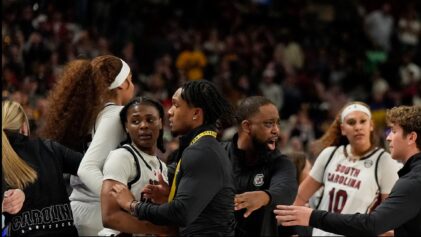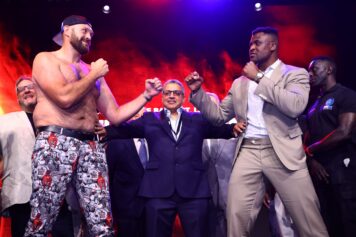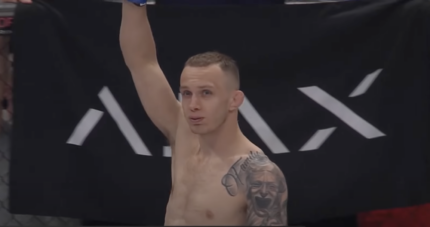(THIS IS PART II OF YOU BETTER RECOGNIZE: MAKING THE CASE FOR MMA. FOR PART I, CLICK HERE)
As throngs of former collegiate wrestlers, contact sportsmen and current street fighters look to the new beacon of athletic hope that is mixed martial arts, one must recognize the shift in the talent pool. It is a shift that, although gradual, came from a place of desperation once the prospect or at least the perception that fame and fortune would follow the successful few. The hip-hop generation, particular those of color, were few and far within MMA.
Sure, you had your unicorns like Kevin "The Beast" Randleman who became a star in Japan via the Pride Fighting Championships promotion and then went on to become UFC Heavyweight Champion in 1999. Or Yves Edwards, one of the most accomplished lightweights in MMA history who coined his brand of fighting, Thug Jitsu, and is still cited by many in the weight class as the reason why they became a professional fighter. But overall, there was no real mass audience and fanfare for these athletes within the hip-hop community or their subset community of color. Fanfare, as we all know, brings sponsors and raises purse amounts, so the lack of support really pigeonholed these fighters to second class to no citizenship when compared to their boxing counterparts during the nineties. The allure of MMA was not evident based on these minimally celebrated stars of the underground, yet a shift would happen as dramatic as hip-hop's rise in popularity.
On January 17th, 2005, the single most important event in the popularizing of MMA as a sport occurred when The Ultimate Fighter reality show debuted on upstart male-centric network, Spike TV. With it came the exposition of the training regimen, nutrition discipline and robust passion in the cage that are now germane to an MMA fighters’ image. As the final episode of season one played out, and a bloodied Forrest Griffin and Stephan Bonnar mercilessly jousters each other from various angles, the word of mouth effect began and the public's true fetish for MMA took a firm hold. During a time when boxing was losing its luster, the world craved a doppelgänger to replace or match the action of the sweet science.
The Rampage-Kimbo Effect
In 2001, Pride FC, Japan's largest MMA promotional company, marketed a relatively unknown fighter named Quinton Jackson. He was billed as a homeless fighter from Memphis, Tennessee and was thrown in against extremely fierce, seasoned competitors. After an early loss, Jackson racked up many victories and respectable losses in Pride FC, eventually becoming one of the most recognizable faces in Japan. By the time Jackson, who began donning the moniker Rampage, came back to the States to continue his rise in popularity, he already possessed both the athleticism and showmanship aspect of being a professional fighter.
Influenced by the marketing positioning that started and succeeded from a box office perspective in Japan, and understanding that one becomes a star by differentiation, Rampage became the howling, chain-wearing professional alter ego of Jackson. This transformation yielded huge dividends at both the arena box office and eventually the silver screen, when Jackson acted out the role of B.A. Baracus in the big budget remake of The A Team. Filling the shoes of Mr. T was not difficult for Rampage who was already a larger than life brash personality within the cage and ring.
In 2003, the underground street fighting scene of Miami came to the attention of the world via YouTube, courtesy of Kevin "Kimbo Slice" Ferguson. Replete with an aggressive beard, gold teeth and admirable mean mug, Ferguson blazed a trail from the backyards of Miami's toughest neighborhoods, and he set his sights on the small screen. Promoters took notice of the deafening internet buzz, and the first to jump on the Kimbo train was a smaller regional promoter that pitted him in a 3 round exhibition against former WBO Heavyweight Champion, Ray Mercer. Ferguson won via guillotine choke at 1:12 of the first round and then catapulted to the masses with promoter EliteXC and CBS. After a few wins and the eventual collapse of EliteXC, Ferguson made the big jump to the UFC through The Ultimate Fighter franchise. Starting from the bottom again, this time as a reality show contestant, Ferguson earned his shot in the UFC until a few losses cemented his pink slip.
The promoters of Kimbo Slice and Rampage knew that these two personalities were very different from the fighters on their respective rosters at the time. Through the rags to riches dichotomy used to catapult both fighters into the mainstream, each promoter and fighter invested in the stereotypes one can assume through pictures and highlight videos. These two seemingly unpolished archetypes from the slums of Miami and Tennessee were there to assert their raw natural power over traditional mixed martial artists. Right or wrong, that unspoken feeling reverberated into the airwaves and made the current and burgeoning MMA fans salivate like Pavlov's famed dogs. However, from this form of marketing of MMA's new elite, a very distinct rift has occurred with the athlete of color: the assumption of the "accepting bad guy" and the "not so willing to be bad" guy.
Case in point is "Suga" Rashad Evans and Jon "Bones" Jones, two of the sport’s most recognizable faces of color that are either former or current UFC Light Heavyweight Champions. Yet both are at an image crossroads.
Evans was the winner of The Ultimate Fighter Season 2 and went undefeated for five years through his first 15 bouts, eight of which were in the UFC against the toughest competitors. The former Michigan State wrestler worked his way up from the junior college level to become an undefeated UFC champion, and did it in quiet eloquent fashion. Yet the prototype MMA fan who regularly purchases pay-per-view and knows each fighter's record by heart have little regard for "Suga." He has been lambasted as the cocky perfectionist instead of lauded for his excellence. Promoters have never pumped the same marketing dollars into his regular guy image and subsequently the media and the fans feel that his slight personality obscurity comes off as cocky.
Then study the corporate maturation of current UFC Light Heavyweight Champion Jon Jones, who recently proved his brand's power by inking sponsorship deals with Gatorade and Under Armour. The fighter is virtually unbeaten with his only loss coming from disqualification for illegal strikes. His brothers are all in the NFL and he is a family man. Although he recently had skirmishes with the law that included a DUI, Jones has risen from a good guy image that now looks like the prototype of MMA athletes on the come up. However, Jones is the bad guy in his matches. When he fights now, people pay to see him dethroned. His last two fights against uber popular trash talkers Chael Sonnen and Swede Alexander Gustafsson saw popular opinion swayed towards the challenger. Jones' financial success has now made him a semi-pariah to the traditional fan partially based on his corporate sponsorship victories.
In addition, there are dozens of fighters not known outside of the sport's die-hards that are deserving of better marketing push and general career revival which would be for the betterment of the sport.
Take Houston Alexander, a fighter who mixes being the top radio DJ in his Omaha, Nebraska market with to raising his six children as a single father. Alexander donated one of his kidneys to his oldest daughter in 2000 and has even rescued a child in his community who was locked in a car. These stories propel not only the sport but provide a platform to further bring in the hip-hop community and communities of color. However, the choice to be a caricature versus an athlete when you're a fighter of color is the unspoken obstacle stunting the growth potential of the sport.
The issue came to head when Rampage fought Rashad Evans during the height of The A-Team movie promo blitz at UFC 114. During a press conference Evans expressed his feeling that Rampage was an "Uncle Tom" exposing his internal disgust of how he felt Rampage positioned his fighting image.
Whether complicit or not, the fact remains that MMA doesn't understand how to cater to its new audience and, until it does, the growth of the hip-hop community as a paying audience will continue to move slowly. However, like hip-hop itself, one can only hope that the commercialization of stereotyped images doesn't make the fighter and audience cannibalize itself to the point of seeming disposable. After all, this too is art and should be revered as such. Broad assumptions of the athletes or the fans based on savage imagery or slum tale bravado will only cheapen the product and zombify the audience. One can look at the current hi- hop music landscape to see how subtly that can happen and why should this indifference creep into this still nascent art form, too.



